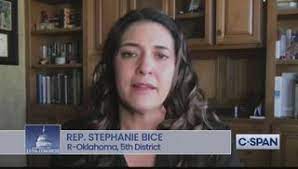
Oklahoma Congresswoman Stephanie Bice urged others on a House Committee hearing to avoid creating more bureaucratic layers as they explored climate change and how the government can provide information.
Rep. Bice spoke as the ranking Republican of the House Committee on Science, Space and Technology Subcommittee on Environment. The subcommittee held a hearing entitled “Working Towards Climate Equity: the Case for a Federal Climate Service,” during which she discussed the impact of reliable climate data on American citizens, and the importance of maximizing effectiveness while minimizing bureaucratic hurdles.
“I am hopeful today’s discussion will focus on what information and data localities need, not just increasing bureaucracy with another government agency or service,” said Bice.
Read her full statement, as prepared for delivery,
here.Thank you, Chairwoman Sherrill. I’m looking forward to this first Subcommittee hearing, as well as a productive relationship throughout this entire Congress.
There are few states who would benefit more from a better understanding of weather and climate than Oklahoma. We’re home to 86,000 farms that feed and clothe our state, our nation, and the world. Entire families’ livelihoods depend on long-term and short-term weather patterns, so any future variations resulting from a changing climate need to be effectively communicated to them.
Arguably the most important component of any farmer’s operation, and a topic of conversation today, is precipitation. It’s common sense that too little rain results in a drought and farmers will have lower yields as a result. But people often overlook that too much rain, either in frequency or volume, also present problems to crop production. Precisely predicting both high and low precipitation informs what crops to plant and when to harvest.
Therefore, accurate and trustworthy data, along with a variety of other information, is essential to an entire industry and many states’ main economic driver. And due to the unique geography of individual states, a mix of federal and local services is ideal. It’s not a one size fits all puzzle.
Currently the federal government, through the National Weather Service and National Oceanic and Atmospheric Administration (NOAA), operates Atlas 14, which provides precipitation frequency estimates that become the standard for relevant regulation, permits and recommended best practices. States use this information for standards in designing, building and operating infrastructure to withstand the forces of heavy precipitation and floods.
At the same time, many states have recognized the need for additional data and have dedicated their own resources to protect lives and properties with accurate forecasts and predictions. There is no better example than Oklahoma, where two of the state’s premier universities – Oklahoma State University and the University of Oklahoma – have long histories of researching weather patterns. The National Weather Center – the nation’s leading facility in researching climate and weather – is based in Norman, Oklahoma.
Additionally, you’ll find no more valued state resource than the Oklahoma Mesonet. Founded as a partnership between OSU and OU, the Mesonet takes weather observations every 5 minutes, then transmits this data to a central processing facility, which in turn puts it out to the public 5 to 10 minutes later. With one Mesonet station in each of Oklahoma’s 77 counties, collecting data 24 hours per day, year-round, weather events like thunderstorms, wind gusts, heatbursts, and drylines can’t go undetected and wreak havoc on an unsuspecting farm or ranch.
I look forward to hearing from Dr. Jeff Basara, a professor and researcher at the University of Oklahoma. His research is focused on land-atmosphere interactions and understanding the complex relationship between weather, climate, water, and ecosystems. He will be able to share with us how he has utilized federal climate information in his research, and how state-based systems like the Mesonet are factoring in climate risks and being used by on-the-ground decision makers. Specifically, Dr. Basara can speak to how the agriculture industry has been at the forefront of adapting to climate and weather risks.
Oklahoma is just one example of a state taking the lead. But as my colleagues from Iowa and Florida will tell you, not everyone is facing the same risks. Soil precipitation data from Oklahoma doesn’t do much good for rising water levels in Florida’s Everglades.
That is why I am hopeful today’s discussion will focus on what information and data localities need, not just increasing bureaucracy with another government agency or service. Through federal-led partnerships with academics, states, and private industry, we can identity what information is most needed and then work to provide it in a cost effective, resourceful way.
Thank you, Chairwoman Sherrill, for hosting this hearing and I yield back the balance of my time.
Source: press release






